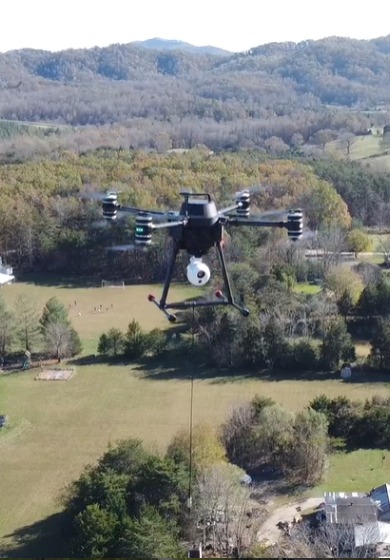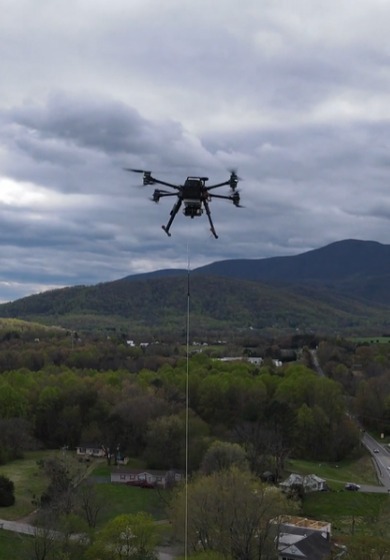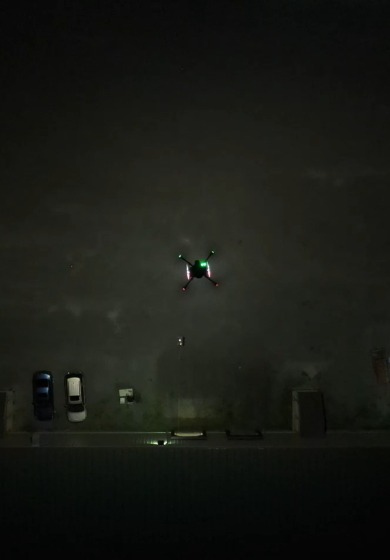What is a tethered drone?
- Home
- What is a tethered drone?
Why Tethered Drones?
The civilian and military use of Unmanned Aerial Vehicle (UAV) systems is rapidly increasing with advancing technologies. In aerial imaging and data collection applications, UAV systems (“drones”), especially with their rotary wing structure, provide various advantages over fixed-wing systems thanks to features such as hovering and vertical take-off and landing. Despite these advantages, their use in tactical areas is limited due to the disadvantage of low hover time. With current technology, the flight time of rotary wing UAVs varies between 30-60 minutes. Especially in applications such as communication relay, wide area surveillance, and traffic monitoring, rotary wing UAVs cannot be used or are used in a limited way due to the need for long-term operation.
Another requirement of UAVs is the need for communication. Data (sensor, image, control, telemetry) communication is provided through the wireless communication network established with the operator. Especially in environments where signal interrupters are used (military applications, rallies, meetings, etc.), turning off the signal interrupters for the use of UAVs creates security gaps. On the other hand, since it is not possible to transfer high-dimensional data via wireless data connection, especially image data is compressed to a much less usable level.
This makes it difficult to use in applications that require high-resolution data, such as wide area surveillance software. Encryption is also used to secure wireless communication against infiltration, but 100% security cannot be achieved.
Tethered drone solutions are mainly based on using the advantages of rotary wing systems like hovering, vertical takeoff and landing, while using a cable connection to the ground unit for transferring data and power, which increases flight time and data security. Unlike conventional drones, tethered drones can remain in the air for an extended period of time, often up to 24 hours, without the need to land for battery replacement or refueling. The purpose of this white paper is to provide a comprehensive overview of what tethered drones are, their components, advantages, use cases, and applications. We will also explore why Zenith Aerotech tethered drones are a popular choice for various industries.

History of Tethered Drones
The concept of tethered drones is not a new one. In fact, the use of tethered balloons for surveillance and other applications dates back to the mid-1800s. However, the modern tethered drone as we know it today has evolved significantly over the past few decades.
In the 1990s, the U.S. military began exploring the use of tethered drones for surveillance and reconnaissance. The first tethered drone to be deployed by the military was the TCOM 17M aerostat, which was used for surveillance during the Gulf War. The TCOM 17M was tethered to a ground-based power source and could remain in the air for up to 14 days at a time.
Since then, tethered drone technology has continued to evolve. The Zenith Aerotech team has been working on tethered drones since 2010. The first prototypes and flight tests were performed in 2010 and, with years of effort, in 2019 Zenith Aerotech announced its first tethered drone products to the market.
In 2021, Zenith Aerotech successfully demonstrated a 108 hour, continuous tethered drone flight which proved the endurance and reliability of tethered drone systems.
Today, tethered drones are used in a wide range of applications, from military and law enforcement to disaster response and agriculture. Their ability to remain in the air for extended periods, transmit real-time data, maintain stability, and reduce risk has made them a valuable tool for businesses and organizations around the world.
Purpose of Tethered Drones

Tethered drones are a type of unmanned aerial vehicle (UAV) that is connected to a ground-based power source via a tether. The purpose of tethered drones is to provide a stable and secure platform for aerial surveillance, monitoring, and data collection. The following are some of the key purposes of tethered drones:
Long-duration Flight:
Tethered drones can stay in the air for hours, days, or even weeks at a time, thanks to their tethered power source. This makes them ideal for applications that require long-duration flight, such as aerial surveillance, monitoring, and data collection.
High-altitude Operation:
Tethered drones can operate at high altitudes, providing a unique perspective of the ground. This makes them ideal for applications such as search and rescue, disaster response, and surveillance.
Real-time Data Transmission:
Tethered drones are equipped with sensors that can collect real-time data, such as high-resolution imagery, video, and sensor data. The tether provides a secure and stable connection for real-time data transmission, making tethered drones ideal for applications that require real-time data collection and analysis.
Improved Stability:
The tethered connection provides a stable platform for the drone, allowing it to maintain a stable position and reduce the effects of wind and other environmental factors. This improves the quality of data collected and makes tethered drones ideal for applications that require stable imaging, such as surveying and inspection.
Reduced Risk:
Tethered drones can be used in applications where traditional drones pose a safety risk, such as airports, military bases, and other high-security areas. The tethered connection ensures that the drone remains in a specific location, reducing the risk of collisions and other safety incidents.
Conclusion:
In conclusion, tethered drones are a valuable tool for aerial surveillance, monitoring, and data collection. Their ability to stay in the air for extended periods, operate at high altitudes, transmit real-time data, maintain stability, and reduce risk makes them ideal for a wide range of applications. Tethered drones have proven to be effective in industries such as military, law enforcement, disaster response, agriculture, and entertainment, among others.
Components of Tethered Drones
Tethered drones are comprised of several components that work together to keep the drone aloft and provide real-time data transmission. The following are some of the critical components of a tethered drone:
Tether: The tether is a cable that connects the drone to the ground. The tether provides power and data transfer capabilities to the drone.
Power supply: The power supply provides power to the drone through the tether. Tethered drones typically use electric power and require a constant power source to stay aloft.
Control station: The control station is the hub of the tethered drone system. It provides the operator with real-time data from the drone’s sensors and allows them to control the drone’s movements.
Sensor payload: The sensor payload is the equipment attached to the drone that collects data. This can include cameras, thermal imaging sensors, and other types of sensors depending on the drone’s intended use.
Advantages of Tethered Drones
Tethered drones offer several advantages over conventional drones. Some of the most significant advantages of tethered drones include:
Long-duration flights: Tethered drones can remain aloft for extended periods, making them ideal for applications that require long-duration monitoring and surveillance.
Uninterrupted power supply: Tethered drones have a constant power supply through the tether, eliminating the need for battery replacement or refueling.
Real-time data transmission: Tethered drones provide real-time data transmission to the ground control station, allowing for immediate decision-making.
High altitude operation: Tethered drones can operate at high altitudes, providing a broader and more comprehensive view of the area being monitored.
Use Cases and Applications of Tethered Drones
Tethered drone systems have a wide range of applications and use cases across various industries. Some of the key applications of tethered drone systems include:
Aerial Surveillance and Monitoring:
Tethered drone systems can be used for aerial surveillance and monitoring in a variety of settings, including border control, critical infrastructure protection, and public safety. The continuous power supply and stable platform provided by the tether enable the drone to remain in the air for extended periods of time, providing a high-resolution view of the target area.
Disaster Response and Recovery:
Tethered drone systems can play a crucial role in disaster response and recovery efforts. They can be used to quickly assess the damage caused by natural disasters, such as earthquakes and hurricanes, and provide real-time data on the situation on the ground. This information can be used to inform decision-making and coordinate response efforts.
Industrial Inspection and Maintenance:
Tethered drone systems can be used for industrial inspection and maintenance tasks, such as inspecting oil rigs, power lines, and wind turbines. The stable platform provided by the tether ensures that the drone can capture high-quality images and data, which can be used to identify potential issues and schedule maintenance.
Public Events and Crowd Control:
Tethered drone systems can be used for public events and crowd control, providing a bird’s eye view of the crowd, and enabling real-time monitoring and response. They can also be used for security purposes, such as identifying potential threats and providing situational awareness to law enforcement.
Agriculture and Environmental Monitoring:
Tethered drone systems can be used for agriculture and environmental monitoring, such as monitoring crop health and soil moisture levels. They can also be used for environmental monitoring, such as tracking wildlife populations and monitoring the health of ecosystems.
Military and Defense:
Tethered drone systems have a variety of military and defense applications, including providing situational awareness in battlefield scenarios, supporting search and rescue operations, and conducting reconnaissance missions.
Why Choose Zenith Aerotech Tethered Drone Systems?
Zenith Aerotech is the leading provider of tethered drone systems with a proven track record of delivering high-performance solutions to various industries. The following are some of the key reasons to choose Zenith Aerotech tethered drone systems:
Advanced Technology:
Zenith Aerotech tethered drone systems are equipped with advanced technology that allows for long-duration flights, real-time data transmission, and high-altitude operation. Their tethered drone systems are designed with a focus on durability, reliability, and performance, making them ideal for use in various industries.
Customization:
Zenith Aerotech offers customizable tethered drone systems to meet the specific needs of their clients. They work closely with their clients to understand their requirements and provide tailored solutions that address their unique challenges.
Ease of Use:
Zenith Aerotech tethered drone systems are designed with ease of use in mind. Their ground control station is user-friendly, allowing operators to easily control the drone’s movements and monitor the data collected by its sensors.
Cost-Effective:
Tethered drone systems can be a costly investment, but Zenith Aerotech offers cost-effective solutions that provide high performance and long-term value. Their tethered drone systems require less maintenance and have a longer lifespan than traditional drones, making them a cost-effective investment for businesses.
Exceptional Customer Support:
Zenith Aerotech offers exceptional customer support to their clients. They provide training, technical support, and maintenance services to ensure that their clients get the most out of their tethered drone systems. Their team of experts is always available to answer any questions or concerns their clients may have.
Diverse Applications:
Zenith Aerotech tethered drone systems can be used in various industries, including military, law enforcement, disaster response, agriculture, and entertainment. Their tethered drone systems are versatile and can be customized to meet the specific needs of each industry.

Conclusion
Tethered drone systems have a wide range of applications and use cases across various industries. They can be used for aerial surveillance and monitoring, disaster response and recovery, industrial inspection and maintenance, public events and crowd control, agriculture and environmental monitoring, and military and defense applications. The continuous power supply and stable platform provided by the tether enable these systems to provide high-quality data and images, making them a valuable tool for a variety of applications.
In conclusion, Zenith Aerotech tethered drone systems are a superior choice for businesses looking to invest in long-duration monitoring, surveillance, and data collection. With their advanced technology, customization, ease of use, cost-effectiveness, exceptional customer support, and diverse applications, Zenith Aerotech tethered drone systems offer a high-performance solution to various industries.
